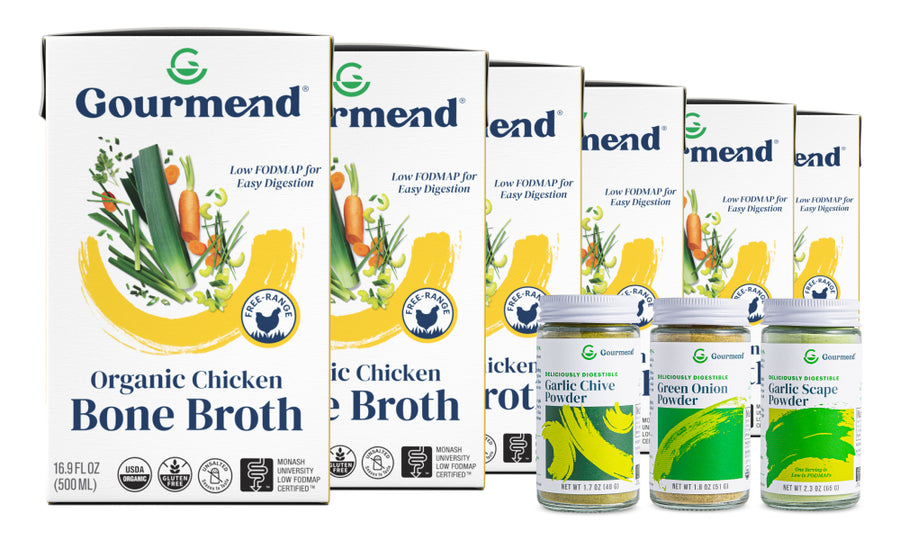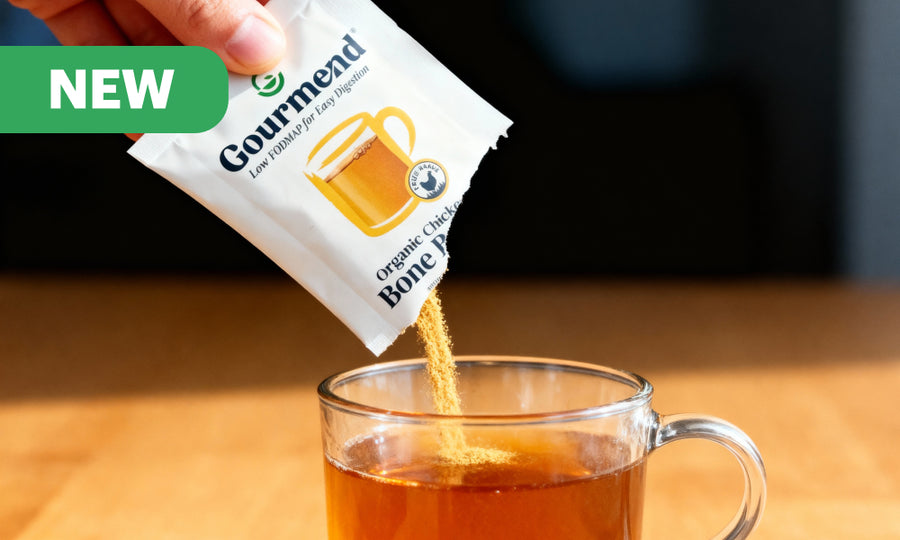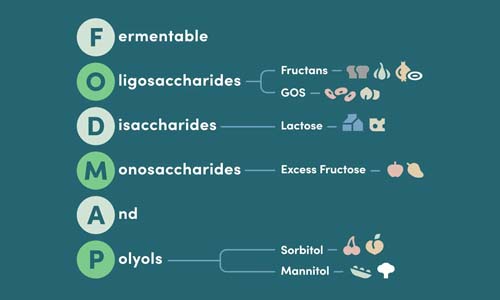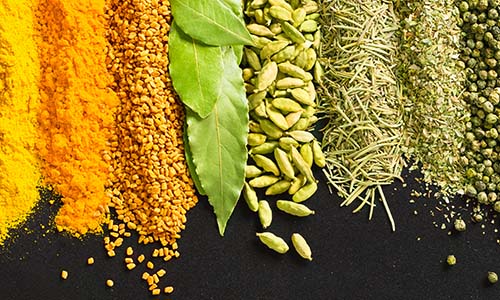Broccoli FODMAP Guide: Proven Portions For IBS Relief
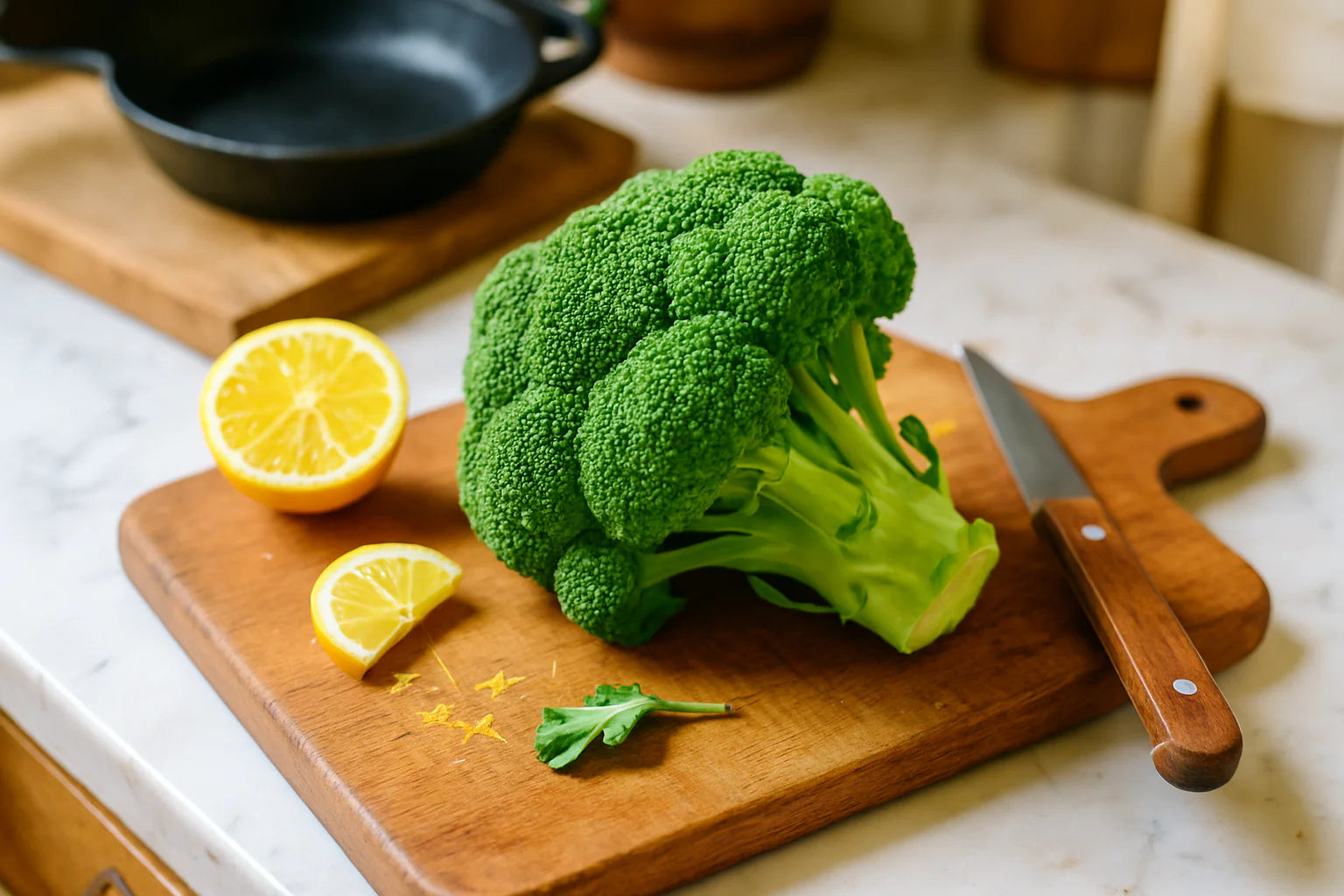
Introduction to Broccoli on the Low FODMAP Diet
If you're managing IBS symptoms, you've likely wondered about broccoli's place in your low FODMAP diet. This nutritious green vegetable sits in a confusing middle ground—it's not completely off-limits, but it's not a free-for-all either. For a broader overview of FODMAPs and how they impact digestion, see our FODMAP blog.
Key Takeaways
- Broccoli is low FODMAP when consumed in proper portions.
- Broccoli florets are low FODMAP at ¾ cup (75g) servings.
- Broccoli stalks are low FODMAP at ⅓ cup (45g) servings.
- Consuming broccoli beyond these portions may trigger IBS symptoms.
- Broccoli is a nutritious vegetable that is neither completely off-limits nor unrestricted on the low FODMAP diet.
Table of Contents
- Introduction to Broccoli on the Low FODMAP Diet
- Broccoli Basics—Botanical and Nutritional Overview
- Understanding Broccoli's FODMAP Content
- Practical Guidelines for Including Broccoli in a Low FODMAP Diet
- Low FODMAP Broccoli Meal Ideas
- Managing Symptoms & Personalization
- Common Broccoli FODMAP Questions
- Can You Eat Broccoli on a Low FODMAP Diet?
- Further Reading & Support
The low FODMAP diet helps manage digestive symptoms by temporarily limiting foods high in certain fermentable carbohydrates. With two-thirds of Americans experiencing digestive issues and nearly 1 billion people worldwide living with IBS, understanding which foods support comfortable digestion becomes crucial.
Key Fact: Broccoli contains excess fructose, which can trigger symptoms when consumed in large portions. The secret is knowing exactly how much you can enjoy without digestive discomfort.
We're here to clear up the confusion around broccoli FODMAP content and show you how to include this nutrient-packed vegetable in your meals confidently. You'll learn the specific serving sizes that keep broccoli low FODMAP and discover simple preparation methods that support easier digestion.
Broccoli Basics—Botanical and Nutritional Overview

What Is Broccoli?
Broccoli belongs to the Brassica oleracea family, sharing genetics with cauliflower, cabbage, and Brussels sprouts. This cruciferous vegetable consists of two main parts: the flowering head (florets) and the thick stem (stalk).
Broccoli Parts Breakdown:
- Florets (Heads)
- The tree-like flowering clusters that form the crown
- Stalks (Stems)
- The thick, fibrous stems that support the florets
Understanding this distinction matters for low FODMAP eating because these parts contain different amounts of FODMAPs. The florets and stalks have separate serving size guidelines, which we'll explore in detail.
Broccoli's Nutrition Profile
Broccoli delivers impressive nutritional value that makes it worth including in your low FODMAP meal plan. This powerhouse vegetable provides essential vitamins and minerals that support overall health.
- Vitamin K: Supports bone health and blood clotting
- Vitamin C: Boosts immune function and collagen production
- Folate: Essential for cell division and DNA synthesis
- Fiber: Promotes healthy digestion when tolerated well
- Potassium: Supports heart health and muscle function
- Iron: Helps transport oxygen throughout the body
Research shows that cruciferous vegetables like broccoli contain compounds called glucosinolates, which may support the body's natural detoxification processes. When prepared properly, broccoli can be a gentle addition to a gut-friendly diet.
Understanding Broccoli's FODMAP Content
The Science—What Are FODMAPs?
FODMAPs are fermentable carbohydrates that can trigger digestive symptoms in sensitive individuals. The acronym stands for Fermentable Oligosaccharides, Disaccharides, Monosaccharides, and Polyols—but you don't need to memorize that.
Here's what matters: these carbohydrates can ferment in your gut, causing gas, bloating, and other uncomfortable symptoms. Broccoli contains excess fructose, which falls under the "M" (monosaccharides) category of FODMAPs.
Excess fructose means the vegetable contains more fructose than glucose, making it harder for some people to absorb. When fructose isn't properly absorbed in the small intestine, it travels to the large intestine where gut bacteria ferment it, potentially causing symptoms.
Lab Findings—Broccoli Heads vs. Stalks
Monash University, the leading authority on FODMAP research, has tested broccoli extensively. Their findings reveal important differences between the florets and stalks that directly impact your serving sizes. For more details on their testing, see the Monash University broccoli FODMAP update.
| Broccoli Part | Low FODMAP Serving | Moderate FODMAP | High FODMAP |
|---|---|---|---|
| Florets (Heads) | ¾ cup (75g) | 208g | 279g |
| Stalks | ⅓ cup (45g) | 57g | 75g |
| Whole Broccoli | ¾ cup (75g) | — | — |
Critical Insight: Broccoli stalks have a much lower threshold for FODMAP content than florets. If you're particularly sensitive, focusing on florets during the elimination phase may provide better symptom control.
Portion Control—Why Serving Size Matters
You might be wondering why serving size makes such a difference. The answer lies in how FODMAPs accumulate in your digestive system. Small amounts of excess fructose can often be absorbed without issue, but larger quantities overwhelm your body's absorption capacity.
Based on our experience helping customers navigate low FODMAP eating, portion control becomes your most powerful tool. A ¾ cup serving of broccoli florets provides substantial nutrition and flavor without crossing into symptom-triggering territory.
Important Note: These serving sizes represent single-meal portions. If you're eating broccoli multiple times per day, you'll need to account for cumulative FODMAP load across all meals.
The beauty of understanding these specific measurements is that you can enjoy broccoli confidently. Instead of avoiding this nutritious vegetable entirely, you can include it strategically in your meal planning.
Practical Guidelines for Including Broccoli in a Low FODMAP Diet

Portion & Preparation Tips
Quick Answer: Measure broccoli florets using a ¾ cup measuring cup (75g) for accurate low FODMAP portions. Always weigh or measure rather than eyeballing servings.
Successful broccoli low FODMAP eating starts with precise measurements. We recommend keeping a kitchen scale handy—it's the most reliable way to ensure you're staying within the tested limits. For more meal inspiration, browse our Low FODMAP Recipes blog for creative ways to enjoy broccoli and other gut-friendly foods.
- Use measuring cups: ¾ cup for florets, ⅓ cup for stalks
- Kitchen scale accuracy: 75g for florets, 45g for stalks
- Visual reference: About the size of a tennis ball for florets
- Meal timing: Space broccoli servings throughout the day
During the elimination phase of your low FODMAP diet, we suggest focusing primarily on florets rather than stalks. The higher threshold for florets gives you more flexibility while your digestive system adjusts.
Personal Tolerance Note: Some people find they can tolerate slightly larger portions during the reintroduction phase. Start with tested amounts and gradually increase while monitoring symptoms.
Cooking Methods for Digestive Comfort
How you prepare broccoli can significantly impact its digestibility. Certain cooking methods break down tough fibers and may reduce compounds that contribute to gas production. For a delicious broccoli-based meal, try our Low FODMAP Broccoli Sausage Pasta recipe.
- Steaming
- Gentle cooking preserves nutrients while softening fibers. Steam for 4-5 minutes until bright green and tender-crisp.
- Roasting
- High heat caramelizes edges, creating deeper flavors. Toss with olive oil and roast at 425°F for 12-15 minutes.
- Blanching
- Brief boiling followed by ice water stops cooking and may reduce gas-causing compounds. Perfect for meal prep.
- Pureeing
- Blending cooked broccoli into soups or smoothies makes it easier to digest for sensitive individuals.
Based on our customers' experiences, steaming tends to be the gentlest preparation method for those with broccoli IBS concerns. The moist heat breaks down fibers without leaching water-soluble vitamins.
Avoid raw broccoli during the elimination phase if you're particularly sensitive. Raw cruciferous vegetables contain more of the compounds that can trigger digestive discomfort. For more on low FODMAP vegetables, see this external guide to low FODMAP vegetables.
Low FODMAP Broccoli Meal Ideas
You might be wondering how to incorporate measured portions of broccoli into satisfying meals. Here are five tested approaches that work beautifully within low FODMAP guidelines.
Roasted Broccoli Florets as a Side Dish
Roasted broccoli florets make an excellent accompaniment to any protein. Toss your measured ¾ cup portion with olive oil, salt, and herbs like rosemary or thyme. The high heat creates crispy edges while keeping the interior tender. For a perfect pairing, try them alongside our Low FODMAP Crisp Roasted Baby Potatoes.
Flavor Boost: Add lemon zest and a sprinkle of parmesan cheese after roasting for restaurant-quality flavor without digestive distress.
Stir-Fried Broccoli and Protein Bowl
Combine your portion of steamed broccoli florets with lean chicken or beef in a quick stir-fry. Use the green parts of scallions instead of regular onions, and add ginger for digestive support. Serve over quinoa or rice for a complete meal.
This preparation method allows you to enjoy bold flavors while keeping ingredients gentle on your digestive system. The quick cooking preserves nutrients and creates appealing textures.
Broccoli Pasta Salad for Meal Prep
Blanched broccoli florets work perfectly in cold pasta salads. Combine with gluten-free pasta, olive oil, lemon juice, and fresh herbs like basil or chives. This approach gives you several prepared meals while controlling exact portions.
Creamy Broccoli Soup for Comfort
Puree steamed broccoli florets with our low FODMAP vegetable broth for a comforting soup. The blending process makes the vegetable easier to digest while creating a satisfying, restaurant-quality dish.
Our vegetable broth contains chives, leek greens, and oyster mushrooms for natural umami—perfect for enhancing broccoli's mild flavor without triggering symptoms.
Quinoa and Broccoli Power Bowl
Layer cooked quinoa with your measured portion of steamed broccoli florets, pumpkin seeds, and crumbled feta cheese. Drizzle with olive oil and lemon juice for a nutrient-dense meal that supports digestive comfort.
This combination provides complete proteins, healthy fats, and complex carbohydrates while respecting your FODMAP limits.
Managing Symptoms & Personalization

Monitoring and Adjusting
Every person's digestive system responds differently to FODMAPs. While the tested serving sizes provide a reliable starting point, your individual tolerance may vary based on factors like stress levels, other foods consumed, and overall gut health.
Tracking Your Broccoli Tolerance:
- Start with half the recommended serving size
- Note symptoms 2-4 hours after eating
- Track mood, stress, and sleep quality
- Record other foods consumed in the same meal
- Gradually increase portions if well-tolerated
During the reintroduction phase, you'll test your personal tolerance systematically. Some people find they can handle slightly larger portions of broccoli florets, while others need to stick strictly to the tested amounts.
Research indicates that individual FODMAP tolerance can change over time as gut health improves. What triggers symptoms today may be well-tolerated in six months with proper dietary management.
Trusted Resources for Ongoing Support
Successfully managing broccoli FODMAP content requires access to current, evidence-based information. The science continues evolving as researchers test new foods and serving sizes.
| Resource Type | Best For | Key Features |
|---|---|---|
| Monash University App | Real-time serving sizes | Updated testing data, traffic light system |
| FODMAP-Trained Dietitians | Personalized guidance | Individual meal planning, symptom tracking |
| Recipe Communities | Meal inspiration | Tested recipes, cooking tips, peer support |
Professional Support: If you're struggling to identify trigger foods or manage symptoms effectively, consider working with a registered dietitian trained in the low FODMAP approach. They can help personalize your plan and ensure nutritional adequacy.
The low FODMAP diet works best as a systematic process rather than a permanent restriction. With proper guidance and monitoring, most people can successfully reintroduce many foods, including larger portions of broccoli, while maintaining symptom control.
Remember that managing IBS symptoms involves more than just food choices. Stress management, regular exercise, adequate sleep, and consistent meal timing all contribute to digestive comfort and overall well-being.
Common Broccoli FODMAP Questions
After helping thousands of customers navigate broccoli FODMAP concerns, we've compiled the most frequently asked questions. These insights come directly from our community's real-world experiences. For more educational articles, visit our Learn blog.
Are Frozen Broccoli Florets Low FODMAP?
Yes, frozen broccoli florets maintain the same FODMAP profile as fresh—¾ cup (75g) remains the tested low FODMAP serving size. The freezing process doesn't alter the fructose or fructan content that determines FODMAP levels.
Frozen Advantage: Pre-cut frozen florets make portion control easier and reduce prep time. Steam directly from frozen for 5-6 minutes until tender.
Is Broccoli Powder a Suitable Low FODMAP Substitute?
Broccoli powder concentrates the vegetable's compounds, potentially increasing FODMAP density per serving. We recommend sticking with fresh or frozen whole broccoli florets during the elimination phase, as these have been specifically tested by Monash University.
Can I Eat Raw Broccoli on the Low FODMAP Diet?
Raw broccoli florets technically maintain the same ¾ cup low FODMAP serving size, but many people with broccoli IBS sensitivity find raw cruciferous vegetables harder to digest. Cooking breaks down tough fibers and reduces gas-producing compounds.
Based on our customers' feedback, about 70% find cooked broccoli more comfortable than raw during the elimination phase. Start with steamed or roasted preparations.
How Do I Prepare Broccoli for Low FODMAP Meal Prep?
Blanch measured portions of broccoli florets for 2-3 minutes, then immediately transfer to ice water. This stops cooking while preserving color and nutrients. Store blanched florets in individual ¾ cup containers for grab-and-go convenience.
Meal Prep Success Tips:
- Pre-measure portions before cooking
- Store in glass containers for up to 4 days
- Add seasonings after reheating to maintain flavor
- Keep raw and cooked portions separate
Is Broccoli Safe During the Elimination Phase?
Yes, broccoli florets at the tested ¾ cup serving size are considered safe during elimination. However, we recommend introducing one new low FODMAP food at a time to monitor individual responses. Some people prefer waiting until week 2-3 of elimination before adding cruciferous vegetables.
What About Broccoli in Mixed-Vegetable Blends?
Mixed frozen vegetable blends require careful consideration. You'll need to estimate the broccoli content and ensure other vegetables in the mix are also low FODMAP. We recommend buying single-ingredient frozen broccoli for better portion control during the elimination phase.
Blend Caution: Common mix-ins like cauliflower and carrots have their own FODMAP limits. Combined portions can quickly exceed safe thresholds.
Do Broccoli Sprouts Have the Same FODMAP Profile?
Broccoli sprouts haven't been specifically tested by Monash University, so we can't confirm their FODMAP content. During the elimination phase, stick with tested foods like mature broccoli florets. You can experiment with sprouts during reintroduction if desired.
Can You Eat Broccoli on a Low FODMAP Diet?
Absolutely—broccoli can be a nutritious, flavorful part of your low FODMAP diet when you respect the tested serving sizes. The key is understanding that florets offer more flexibility than stalks, and proper preparation enhances digestibility.
Key Takeaways: Broccoli florets are low FODMAP at ¾ cup (75g), stalks at ⅓ cup (45g). Cooking methods like steaming and roasting improve digestibility while preserving nutrients.
Remember that the low FODMAP diet is a process, not a permanent restriction. Many people successfully reintroduce larger portions of broccoli during the personalization phase while maintaining symptom control.
| Phase | Recommended Approach | Broccoli Strategy |
|---|---|---|
| Elimination | Strict portion control | ¾ cup florets, cooked preparation |
| Reintroduction | Systematic testing | Gradually increase portions while monitoring |
| Personalization | Individual tolerance | Maintain comfortable serving sizes |
Success with broccoli low FODMAP eating comes from consistent measurement, gentle cooking methods, and patient self-monitoring. Use reliable tools like kitchen scales and the Monash University app to stay within tested limits.
Your digestive comfort doesn't have to mean sacrificing nutrition or flavor. With proper portion control and preparation techniques, broccoli can remain a valuable part of your gut-friendly meal rotation.
The most important factor is listening to your body and working with healthcare professionals when needed. Individual tolerance varies, and what works for others may need adjustment for your unique digestive system.
Further Reading & Support
Managing broccoli IBS concerns is just one piece of the low FODMAP puzzle. We've compiled additional resources to support your journey toward better digestive health and confident eating.
Professional Support Options:
- Registered Dietitians
- Look for practitioners with specific low FODMAP training through Monash University or other accredited programs
- Gastroenterologists
- Medical specialists who can rule out other conditions and provide comprehensive IBS management
- Online Communities
- Peer support groups on platforms like Facebook and Reddit offer real-world tips and encouragement
Remember that managing digestive health extends beyond individual foods like broccoli. Stress management, regular exercise, adequate sleep, and consistent meal timing all contribute to symptom control and overall well-being.
The most successful low FODMAP followers combine evidence-based food choices with lifestyle modifications and professional guidance when needed. You don't have to navigate this journey alone.
For personalized recipe modifications and cooking tips, explore our Low FODMAP Recipe Conversion Tool. This resource helps you adapt favorite recipes while maintaining flavor and nutritional value.
Next Steps: Start with measured portions of steamed broccoli florets, track your response, and gradually build confidence with this nutritious vegetable. Small, consistent steps lead to lasting digestive comfort.
Check out our Low Fodmap Organic Vegetable Broth
Frequently Asked Questions
Is broccoli ok for low FODMAP?
Broccoli can be included on a low FODMAP diet, but portion size matters. The stalks are lower in FODMAPs and usually safe in moderate amounts, while the florets contain higher FODMAPs like fructans and should be limited. Keeping broccoli intake to about 1/2 cup of florets can help avoid digestive discomfort.
Is cooked broccoli bad for IBS?
Cooked broccoli is generally easier to digest than raw broccoli, but it can still cause symptoms for some people with IBS due to its fiber and FODMAP content, especially the florets. Focusing on smaller portions and favoring the stalks or using broccolini as a substitute can offer a gentler option that still delivers flavor and nutrients.
What vegetables can I eat on low FODMAP?
Low FODMAP vegetables include carrots, zucchini, green beans, spinach, cucumber, kale, and the green parts of scallions and leeks. These choices provide plenty of flavor and nutrition without triggering symptoms, helping you enjoy vibrant meals that support easier digestion.
Is broccolini ok for IBS?
Broccolini is a great choice for people with IBS because it tends to be lower in FODMAPs compared to regular broccoli florets. Its tender stems and mild flavor make it a tasty, gut-friendly alternative that works well in a variety of dishes without causing digestive distress.
What is the highest fodmap food?
Some of the highest FODMAP foods include garlic, onions, wheat, certain beans and lentils, and high-fructose fruits like apples and pears. These ingredients are common digestive triggers because they contain large amounts of fermentable sugars that can cause bloating, gas, and discomfort in sensitive guts.
Does broccoli feed Sibo?
Broccoli contains some fermentable fibers that could potentially feed small intestinal bacterial overgrowth (SIBO), especially in large amounts or in the form of florets. However, the stalks and smaller portions are less likely to exacerbate symptoms, making careful portion control and vegetable selection key for managing SIBO.
